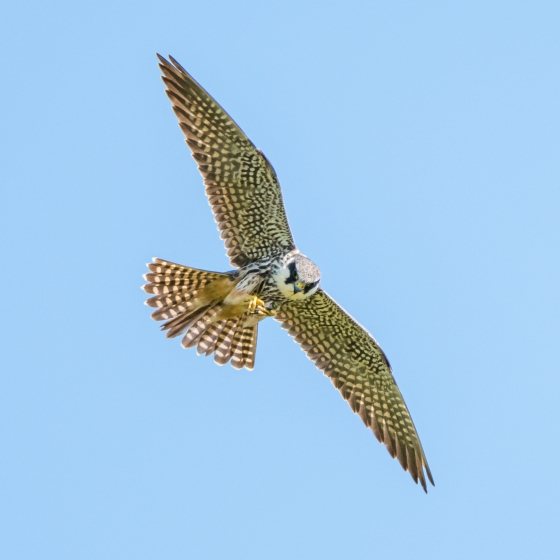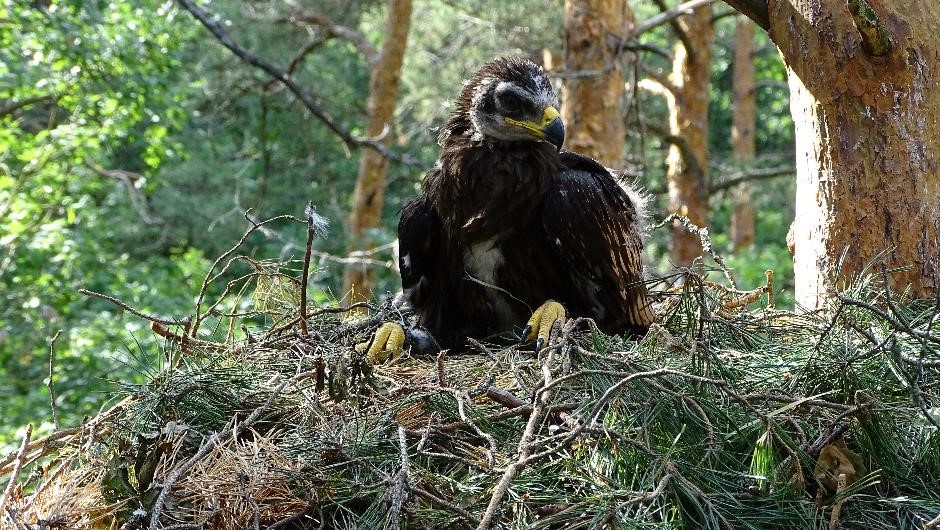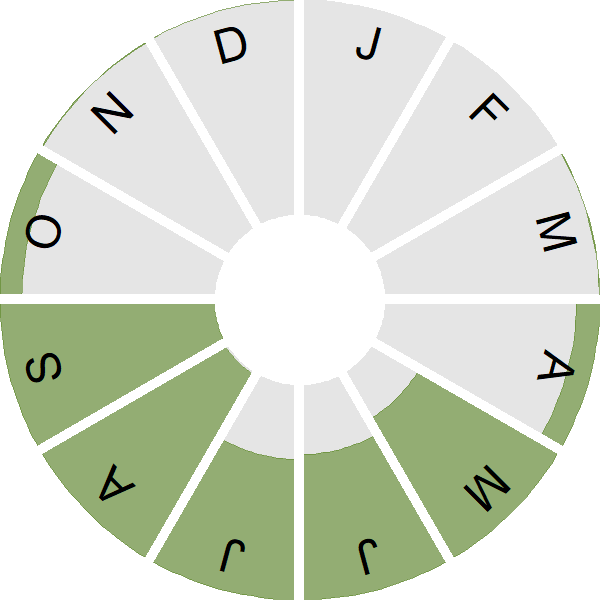Hobby

Introduction
The Hobby is always an exciting bird to see in flight, with its scythe-like wings, deftly hunting dragonflies or hirundines over wetland sites and lowland farmland.
Relatively scarce and secretive when breeding, the Hobby is a difficult bird to census. A few thousand pairs are thought to breed here, with the population restricted to the southern half of Britain and exhibiting greatest abundance in the south-east.
Arriving from Africa in April this Kestrel-sized but longer-winged falcon prefers open countryside, where it chases birds and insects with aerobatic mastery, often eating small prey on the wing.
- Our Trends Explorer gives you the latest insight into how this species' population is changing.

Key Stats
Identification
ID Videos
This section features BTO training videos headlining this species, or featuring it as a potential confusion species.
Hobby & Kestrel
Peregrine
Songs and Calls
Call:
Begging call:
Status and Trends
Conservation Status
Population Change
This species used to be too rare and unobtrusive for wide-scale monitoring but, following population increase, BBS is now able to produce a trend. Many BBS sightings, however, are likely to refer to migrants, first-summer non-breeders, or to breeding birds from distant nests. To establish whether nesting occurs in a locality, dedicated observers and specialised field methods are required, as described by Hardey et al. (2009). The Rare Breeding Birds Panel collects annual data on nesting pairs, which under-represent the true population to an unknown degree, but adequately establish the long-term upward trend (eg Holling & RBBP 2014). RBBP guidelines for recording this species are here. Numbers in parts of southeast England could be considerably higher than previously recognised (Clements & Everett 2012). Clements et al. (2016) looked at breeding densities from recent survey work in several areas, and concluded that the lower limit to the UK population estimate was 3,000 to 3,500 pairs, with perhaps as many as 5,000 pairs breeding. However, this is a tentative estimate, which needs to be confirmed with a full survey.
The Hobby's distribution has spread markedly northwards in England since the 1970s (Gibbons et al. 1993). The species is now widespread north to Lancashire and Co Durham (Balmer et al. 2013).
Distribution
Hobbies are widespread in south and central Britain, with the exception of west Wales and Cornwall where they remain scarce. Further north they are thinly distributed as far north as south Northumberland. A small number breed in the Scottish Highlands but sporadic nesting pairs elsewhere in Scotland may have been overlooked.
Occupied 10-km squares in UK
or view it on Bird Atlas Mapstore.
or view it on Bird Atlas Mapstore.
European Distribution Map
Distribution Change
Hobbies have undergone a large range expansion, now occupying four times as many 10-km squares as in the 1968–72 Breeding Atlas.
Change in occupied 10-km squares in the UK
or view it on Bird Atlas Mapstore.
or view it on Bird Atlas Mapstore.
Seasonality
Hobby is a summer visitor, mostly arriving from late April, with last birds departing in October and sometimes November.
Weekly pattern of occurrence
The graph shows when the species is present in the UK, with taller bars indicating a higher likelihood of encountering the species in appropriate regions and habitats.

Movement
Britain & Ireland movement
Foreign locations of birds ringed or recovered in Britain & Ireland
Dots show the foreign destinations of birds ringed in Britain & Ireland, and the origins of birds ringed overseas that were subsequently recaptured, resighted or found dead in Britain & Ireland. Dot colours indicate the time of year that the species was present at the location.
- Winter (Nov-Feb)
- Spring (Mar-Apr)
- Summer (May-Jul)
- Autumn (Aug-Oct)

European movements
EuroBirdPortal uses birdwatcher's records, such as those logged in BirdTrack to map the flows of birds as they arrive and depart Europe. See maps for this species here.
The Eurasian-African Migration Atlas shows movements of individual birds ringed or recovered in Europe. See maps for this species here.
Biology
Productivity and Nesting
Nesting timing
Egg measurements
Clutch Size
Incubation
Fledging
Survival and Longevity
Survival is shown as the proportion of birds surviving from one year to the next and is derived from bird ringing data. It can also be used to estimate how long birds typically live.
View number ringed each year in the Online Ringing Report.
lifespan
Survival of adults
Survival of juveniles
Biometrics
Wing length and body weights are from live birds (source).
Ring Size
Classification, names and codes
Classification and Codes
- Order: Falconiformes
- Family: Falconidae
- Scientific name: Falco subbuteo
- Authority: Linnaeus, 1758
- BTO 2-letter code: HY
- BTO 5-letter code: HOBBY
- Euring code number: 3100
Alternate species names
- Catalan: falcó mostatxut europeu
- Czech: ostríž lesní
- Danish: Lærkefalk
- Dutch: Boomvalk
- Estonian: lõopistrik
- Finnish: nuolihaukka
- French: Faucon hobereau
- Gaelic: Gormag
- German: Baumfalke
- Hungarian: kabasólyom
- Icelandic: Gunnfálki
- Irish: Fabhcún Coille
- Italian: Lodolaio
- Latvian: bezdeligu piekuns
- Lithuanian: eurazinis sketsakalis
- Norwegian: Lerkefalk
- Polish: kobuz
- Portuguese: ógea
- Slovak: sokol lastoviciar
- Slovenian: škrjancar
- Spanish: Alcotán europeo
- Swedish: lärkfalk
- Welsh: Hebog yr Ehedydd
Research
Causes of Change and Solutions
Causes of change
The causes of change are unclear, although changes in prey availability and a decreasing dependency on its traditional heathland habitat have been suggested as speculative reasons for the increases.
Further information on causes of change
The increases and northward range expansion since the 1970s are perhaps linked to increases in its dragonfly prey supplies (Prince & Clarke 1993) and to a decreasing dependency on its traditional heathland habitat, but the reasons underlying the increase are still only speculative (Clements 2001).
A success rate of more than 90% was recorded for nests in Derbyshire during 1992-2001, with successful nests fledging a mean of 2.44 young (Messenger & Roome 2007). The small annual samples of nest record cards indicate no long-term change in nest success.
Information about conservation actions
The trend for Hobby in the UK is stable or increasing, hence no specific conservation actions are currently required for this species. The causes of change are unclear and no conservation recommendations related to this species have been proposed.
Publications (1)
Long-term effects of rewilding on species composition: 22 years of raptor monitoring in the Chernobyl Exclusion Zone
Author: Dombrovski, V.C., Zhurauliou, D.V. & Ashton-Butt, A.
Published: 2022
Researchers from BTO and the scientific department of Belarusian Chernobyl analysed 22 years of raptor population data from the Chernobyl Exclusion Zone (CEZ) and identified the impact of reduced human activity on some of Europe’s rarest birds of prey. Their findings demonstrate the power of rewilding for supporting biodiversity, including the conservation of vulnerable species.
19.01.22
Papers


